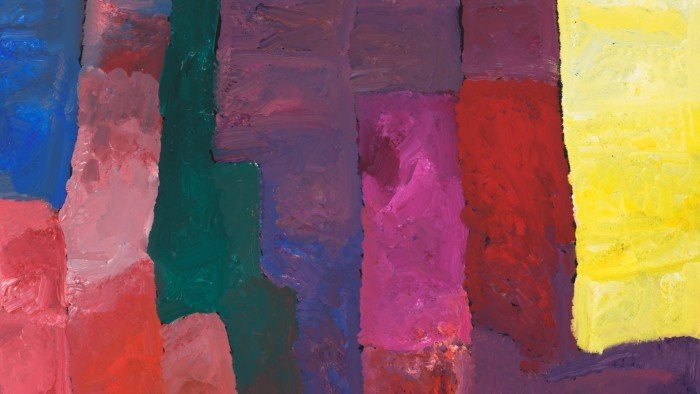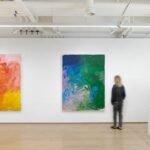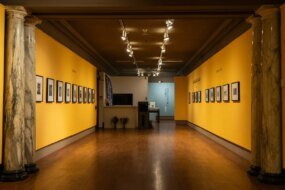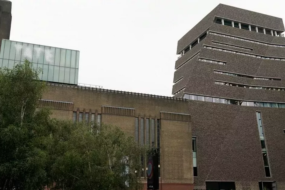
Delicate, geometric chaguar plant weavings hang from tree branches in London’s Cecilia Brunson Projects gallery. They showcase the skills of Silät, a collective of more than 100 women of all ages from north-west Argentina’s Wichí people. Led by Claudia Alarcón, the group’s practice originates in making fishing nets and bags sold at local craft markets. The weavings are a striking example of how art made by indigenous people and communities is gaining prominence in commercial exhibitions. But with increased demand, also come new considerations for the art market, stretching from questions of cultural respect to fair financial share.
Much of the recent attention has been spurred by last year’s Venice Biennale, whose main exhibition, Foreigners Everywhere, spotlighted previously overlooked communities — including Alarcón and the Silät collective. Countries such as the US, Brazil and Denmark opened their pavilions to indigenous artists, while the winner of the coveted Golden Lion award was Archie Moore, of Australia’s Bigambul and Kamilaroi nations, whose work explicitly traced his ancestry back 65,000 years.
Museums have taken note, notably London’s Tate, which acquired Moore’s “kith and kin” from Venice, in partnership with the Queensland Art Gallery | Gallery of Modern Art last year. Tate Modern’s next exhibition is of the Northern Territory artist Emily Kam Kngwarray, one of the more visible 20th-century indigenous artists on the international scene, while its forthcoming annual Turbine Hall commission comes courtesy of Norway’s Northern Sámi artist Máret Ánne Sara. In 2022, Sara was one of three artists who marked the rebrand of the Nordic Pavilion in Venice as the Sámi Pavilion.
It was only a matter of time before the commercial sector followed suit, particularly in a shaky market in which galleries are seeking new avenues to explore. Cecilia Brunson’s Claudia Alarcón & Silät show follows a recent solo exhibition at James Cohan gallery in New York, while other current shows include Kngwarray’s solo show at Pace in London — the gallery began working with the artist alongside the Melbourne-founded D’Lan Contemporary last year.

Also in London, JGM Gallery has a show of six contemporary artists in the circle of Kngwarray. From the same Urapuntja (Utopia) community, the painters in the show are described as “kinship” relatives, a system of connection that means they often carry the same “skin name”, assigned based on community affiliation, in this case Kngwarray. These include Judy Kngwarray Greenie, Emily’s granddaughter by kinship, who in works such as “Atnwelarr” (2025) shows the most similarity to her senior, pressing her brush heavily into the canvas to turn a yam root into an earth-toned abstract.
Galleries are vigorously promoting these relatively new names. On one level, this involves pointing out the clear links with western art. At JGM Gallery, Kudditji Kngwarreye, the only man in the show and Emily’s kinship brother, works in large blocks of colour, which “for some critics . . . resembles the numinous colour field paintings of Mark Rothko”, a gallery statement says. Cecilia Brunson Projects notes how the 20th-century artist Anni Albers took inspiration from the pre-Colombian weavers in South America and owned textiles by the Wichí people. But works at both shows come at a snip of the price of ones by their 20th-century counterparts — the Utopia paintings peak at £12,000; Alarcón’s at £37,000.
At the same time, indigenous art’s messages of community and custodianship of the land chime with today’s more ecologically aware and mission-driven buyers. “Kinship broadly involves responsibility and applies to the land, the animals, the plants as well as to people,” says Antonia Crichton-Brown, a writer and researcher for JGM Gallery.
Overlooked artists, including those who are self-taught and outside of the western canon, are also having their market moment. Not everyone is a fan. Critical debate erupted at the start of this year when, in a Harper’s Magazine feature titled “The Painted Protest”, the arts writer Dean Kissick took aim at the identity politics of the Venice Biennale and other shows, saying they “exhibited recycled junk, traditional craft, and folk art”. In response, the critic and broadcaster Ben Luke wrote in The Art Newspaper that “more equitable and diverse contemporary programming is not only just, but has provided some of the most profound art experiences of my lifetime.” He concludes “bad art abounds, some curators overstretch themes, wall texts are often clunky — it was ever thus.”


There are still many sensitivities when it comes to creating a fine art market from indigenous practices. Crichton-Brown identifies an uncomfortable “distance between the context of being seen in a white-walled gallery in London and the lived conditions of artists in remote regions”. Equally, a craving for apparent authenticity can conjure up an outdated, limiting and insulting representation of a “primitive” people. In reality, Crichton-Brown says, “everyone now has a mobile phone” — indeed one of the longest-running awards for indigenous art, Australia’s National Aboriginal and Torres Strait Islander Art Awards, is sponsored by the country’s leading telecoms provider, Telstra.
Meanwhile, shared “dreamings”, the ancestral forces that underpin the communal and creative processes, are often not verbalised, let alone monetised. A complex system of intermediaries and art centres has been built to protect the concepts of collective memory and custodianship, which do not fit easily into the 21st-century art market system.
Galleries are making efforts to meet the new dynamics. Cecilia Brunson Projects is taking less than the typical primary market gallery percentage for Claudia Alarcón & Silät. “The traditional approach tends to divide acquisition profits equally between gallery and artist, but we’ve adapted to reflect the collective nature of the work and the realities of the community,” Brunson says. For the Emily Kam Kngwarray exhibition, which is a secondary market (resale) show, D’Lan Contemporary and Pace have agreed to gift 10 per cent of their proceeds back to the Urapuntja community. The artist’s estate will also get a capped resale right. As a matter of course, D’Lan Contemporary now also commits 30 per cent of its net annual profits to the broader indigenous communities.
“It has been game-changing,” says gallery founder D’Lan Davidson. “Before it was a one-way street in the market, now the practices have some sustainability.” The industry around indigenous art has a delicate balance to strike, but, Crichton-Brown says, “when it works, it enables communities to perpetuate their belief system while allowing them to make a living and to thrive.”







